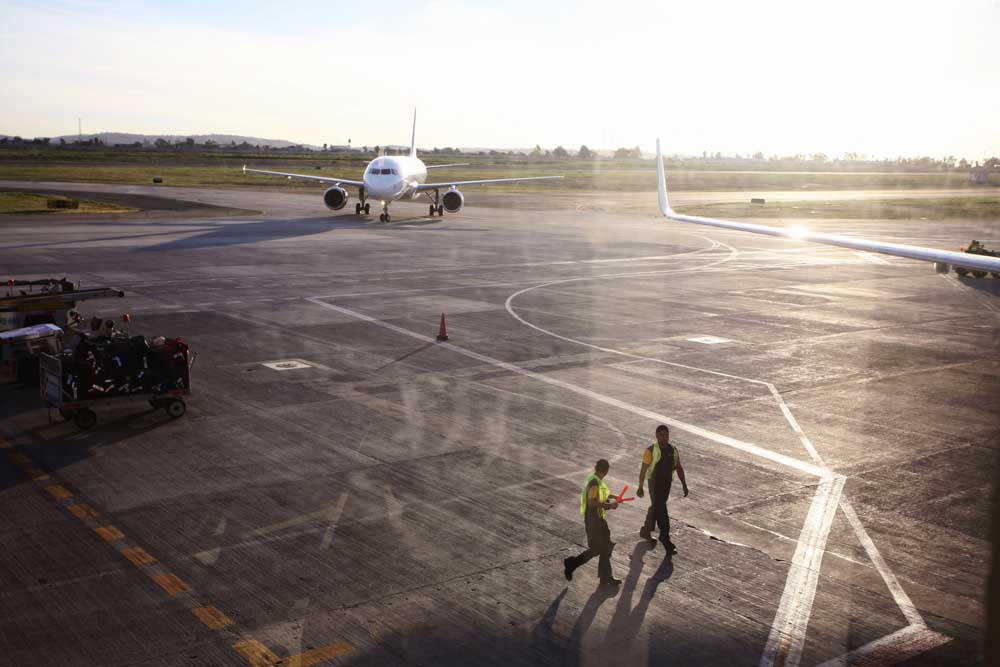How to fly to Mexico by crossing border into Tijuana airport
Published 2:25 pm Wednesday, June 21, 2017

- Approximately 1.5 million of the 6.3 million passengers who flew out of Tijuana in 2016 used the toll bridge. (Dreamstime)
The idea seemed ludicrous: Build a bridge from San Diego directly into the Tijuana airport.
I was intrigued when I heard this because I like to fly out of the Tijuana airport to save money.
Trending
You save international departure taxes and take advantage of the favorable exchange rate. But it’s a hassle to cross the border on foot. Or not on foot. It’s just a hassle to cross the border.
But I never thought they’d actually build the bridge. I figured it was just one of those good ideas that would get bogged down in the details.
That’s why I was amazed when it opened in December 2015, and when I recently found myself walking over it on the way down to Baja California Sur to go whale watching. It works so well that 1.5 million of the 6.3 million passengers who flew out of Tijuana in 2016 used the toll bridge. And that number continues to grow.
It’s pretty simple. You drive to Otay Mesa, 22 miles from downtown San Diego. There’s a border crossing there close to the Tijuana airport.
In the past, we’d park in a secure paid lot on the San Diego side, then wheel our suitcases several blocks before entering the border area, crossing into Mexico through metal doors, then a few more blocks to hop a cab to the airport. On the return, we’d pick up our bags, buy a ticket for a taxi back to the border crossing, then stand in line — sometimes for three hours — to go through customs and cross back into the U.S.
Now, however, there’s an alternate path. Let me walk you through 10 steps to show you how it works. Are you ready? Vamos a Mexico!
Trending
1. Park your car at an airport-style lot in San Diego
It’s run by the Cross Border Xpress. Parking costs $17 per day on the 55-acre property at 2745 Otay Pacific Drive.
2. Enter the new terminal
It looks very airportish, and you buy your $16 (one way) ticket at one of the kiosks. This ticket enables you to use the Cross Border Xpress toll bridge to enter Mexico.
3. Fill out your Mexican immigration form
That’s required on the other side of the bridge.
4. Show your ticket and airline boarding pass at the entrance
There are baggage carts if you need them and a duty-free shop. Then, you enter the fully enclosed bridge, luggage in tow. It’s 390 feet long and 33 feet wide.
5. Take note halfway across
You’ll see a bronze plaque that marks the U.S.-Mexico border. Then you’ll come to a small Mexican immigration facility, where you’ll show your passport and tourist visa form. Don’t be scared by the word “visa”; you don’t need to get it in advance if you’re a U.S. citizen. If you’ll be in Mexico less than a week, you don’t have to pay anything, at this writing. If longer, you’ll have to shell out around $17 in cash. Make sure you keep your visa; you’ll have to show it when you leave.
6. Emerge in Tijuana airport
It has only one terminal, which is clean and has all the junk food you need: a Starbucks, a Carl’s Jr. and a Subway. And of course a bar, for those early morning cocktails. More than 6 million people flew out of this airport last year to 30 destinations.
7. Check in for your flight
Get on your plane and fly to your destination. You can also fly to a few foreign destinations from here, including Central America, though you generally have to change planes.
8. Reverse the process to return
You pick up your luggage and you’ll have to put it through an X-ray machine before leaving the terminal. Then, you use your ticket or buy one to cross back over the bridge.
9. Go through American customs
You’ll see agents in a familiar-looking setup, where you may have to wait for a few minutes, but nothing like the line at the regular borders. Flash your passport; go through the baggage inspection area, which generally takes a few seconds; and re-enter the U.S.
10. Pick up your vehicle
Cart your things out to your car, pay your parking fee. Hit the freeway and head home.
Now, here’s the downside: They don’t speak as much English as they should in this airport, considering that 74 percent of the people who fly in and out cross the border at some point. Luckily for me, I speak enough Spanish to get around, but if you don’t, prepare to use a lot of gestures.
At the counter for Volaris — the biggest carrier from Tijuana — they’ll always dig up someone who speaks English to help you. But remember that you are in Mexico, despite the presence of the Carl’s Jr. and Starbucks. The good news is, the customers can actually help you more than the staff. Ordering at Subway on a recent trip, a woman in line behind me helped me translate “veggie burger” for the person behind the counter.
The other good news is, there’s a shop in the airport that sells yummy wines from Baja California. They’ll let you bring them on the plane, too, since you’ve already passed security.
Flying from Tijuana
Volaris is sort of the Spirit Airlines of Mexico. So the fares, which you can find on Volaris.com, are low. The downside is that you have to pay extra for nearly everything except the air that you breathe. The good news is that, at this writing, you can check a bag for free. However, a carry-on suitcase will cost you. So will food and drink. So bring your own. Volaris has two hubs in Mexico — Tijuana and Guadalajara. So it’s very easy to fly in and out of those destinations.








